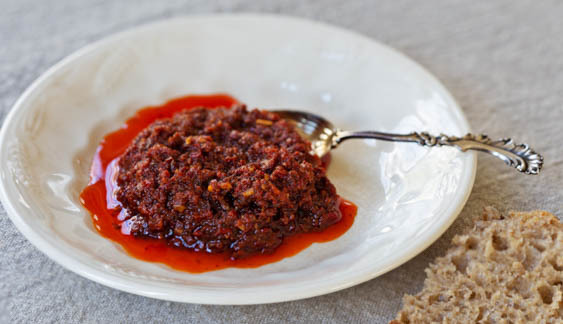Harissa

introduction
A spectacular version of harissa at a North African restaurant in New York City inspired us to recreate that brick-red, intricately spiced pepper paste in the Anson Mills Kitchen. Harissa takes different guises and ingredients depending on its regional bearing. Some are based strictly on dry spice ingredients and “hydrated” with oil; others blend dried chiles with fresh or concentrated tomato; some are smooth while others are chunky. With a taste-memory and picture in our minds, we worked through several renditions to achieve this recipe.
In the end, we whipped up a well-spiced sauce with a kick of heat from Aleppo pepper, a fruity roundness from high-quality sun-dried tomatoes and guajillo chiles, and a smoky sweetness from roasted red peppers—the latter an unconventional addition, but one we think brings the other ingredients into harmony.
Cooking Remarks
The ingredient list may seem long for this condiment and the procedure a bit tedious, but we promise it is worth the effort. If your spice cabinet has been neglected over time, it’s time to refresh your supply. Bulk spice purveyors are often a good bet—you can purchase less of what you require so almost-full jars won’t go to waste again.
For super-smooth roasted pepper and chile purées, we rely on a small Vitamix blender (the model with a 40-ounce jar). But if you don’t have one, no need to worry. Your blender may not deliver the purées to velvety smoothness, but a little texture will not hurt this rustic sauce—if you source good ingredients this sauce will sing.
Another note on the individual purées: you will make more of each than is needed for the harissa. Extras can be stored in the fridge for about a week. The yield on this recipe is modest, and that is intentional. This sauce doesn’t age well and is best eaten within hours of being made. The extra purées will make it simple to throw together another batch a couple days later, because we know you’ll want this condiment around after you try it.
equipment mise en place
For this recipe, you will need a digital kitchen scale; heatproof medium bowl; two small plates; a pair of tongs; a small foil-lined baking sheet if your cook top is electric; three small bowls; a small skillet; a spice grinder; a small, high-powered blender, such as a Vitamix with a 40-ounce jar; a small saucepan; a silicone spatula; and a fine-mesh strainer.
-
-
0.6ounce guajillo chiles (about 4 medium)
-
Boiling spring or filtered water
-
1medium red bell pepper
-
1teaspoon coriander seeds
-
½teaspoon cumin seeds
-
½teaspoon caraway seeds
-
2tablespoons Aleppo pepper
-
2small garlic cloves (germ removed if present), minced
-
2tablespoons minced oil-packed sun-dried tomatoes (pat dry before mincing)
-
3tablespoons extra-virgin olive oil
-
½teaspoon fine sea salt
-
1teaspoon grated zest, plus 1 teaspoon juice from 1 lemon
-
1teaspoon red wine vinegar
-
-
Remove and discard the stems from the guajillo chiles, then shake out the seeds and discard them, too. Tear the pods into pieces and place in a heatproof medium bowl. Cover the chiles with an inch or two of boiling water, then place a small plate on top to keep them fully submerged. Set aside until the chiles are fully hydrated, 30 to 45 minutes; meanwhile, prepare the remaining ingredients.
-
If you have a gas cook top, turn a burner to high. Place the bell pepper directly on the burner and roast, turning occasionally with tongs, until all sides are blackened and charred. If your cook top is electric, adjust an oven rack to the upper-middle position and heat the broiler. Place the bell pepper on a small foil-lined small baking sheet and broil, occasionally turning with tongs, until blackened and charred on all sides. Immediately place the roasted pepper in a small bowl, cover tightly with plastic wrap, and let steam for about 15 minutes.
-
While the pepper steams, in a small skillet, toast the coriander, cumin, and caraway seeds over medium heat until they darken ever-so-slightly and release their fragrance, 1 to 2 minutes. Transfer to a small plate and let cool to room temperature. Place the toasted seeds in a spice grinder and pulverize to a fine powder. Transfer to a small bowl and set aside.
-
Remove the roasted pepper from the bowl. Peel away the blackened skin and remove and discard the stem and seeds. Chop the flesh, then place in a small, high-powered blender (such as a Vitamix with a 40-ounce jar) and process until smooth. Transfer to a small bowl and set aside; reserve the blender jar.
-
To the ground toasted spices, add the Aleppo pepper, garlic, and sun-dried tomatoes and stir to combine. In a small saucepan, warm the olive oil in over medium-low heat until shimmering. Scrape the spice mixture into the hot oil (it should sizzle gently) and mix with a silicone spatula to evenly disperse. Remove the pan from the heat and let cool to room temperature.
-
Drain the guajillo chiles in a fine-mesh strainer, reserving the soaking liquid. Weigh the drained chiles on a digital scale and take note of the weight. Transfer the chiles to the blender. Multiply the weight of the guajillo chiles by 0.67; this is the amount of the reserved soaking water needed to achieve a smooth puree. (For instance, if you have 2 ounces guajillo chiles, you will need 1.3 ounces soaking water.) Add the measured soaking water to the blender and blend on high until the chile purée is smooth. Transfer to a second small bowl and set aside.
-
Once the spice-oil mixture has cooled, add the salt, lemon zest and juice, vinegar, 1.5 ounces of the red pepper purée, and 1.5 ounces of the guajillo purée. Stir until well combined and serve.